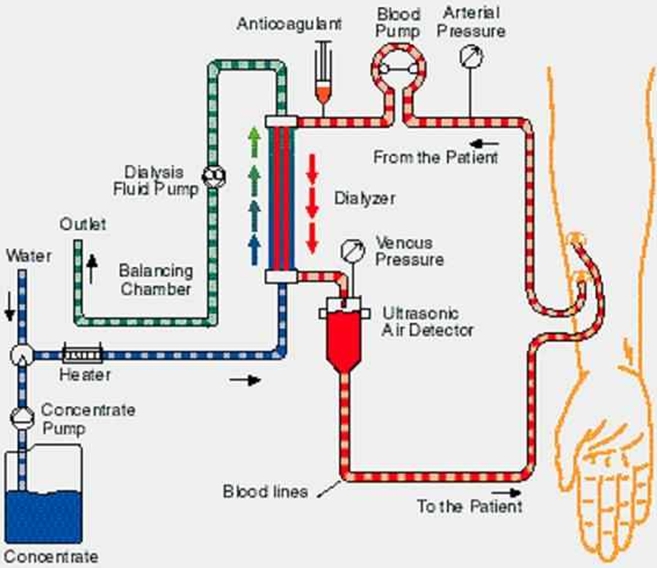| Learning Aims: | ||||||
|
||||||
| Materials: | ||||||
|
||||||
| Suggestions for use: | ||||||
|
Students will be first motivated by a short story informing briefly about the development of artificial kidney and this topic will be discussed with them. Then they will be asked to supply the worksheet table with the properties that the artificial kidney should have in order to save human life and their answer will be justified. Which properties should it have in order to save human life?
Subsequently, students complement their existing knowledge about kidney function and structure of the retrieved information on the operating principle of artificial kidneys from scientific literature or the Internet. Based on the information obtained, they will draw a diagram of functioning of artificial kidney. On what principle should it operate? During dialysis, a dialysis unit (artificial kidney) provides an extracorporeal circulation and produces a dialysis solution. This solution must have the exact composition and temperature. The solution a mixture of water and its solutes (sodium, potassium, calcium, magnesium, chlorine, bicarbonate anion, glucose). For central water treatment in the dialysis centre, a water treatment plant is used, which is based on the principle of reverse osmosis. It is a water filtration through membranes under high pressure. In addition to the dialysis unit itself, a dialyzer is necessary for dialysis. It consists of a semipermeable membrane that separates blood from the dialysis solution. This membrane allows the passage of substances with small molecules (urea, creatinine, etc.) as well as of excess fluid from the bloodstream of the patient. These components are transferred to the dialysis solution and with it they then leave the dialysis unit as waste. Today, capillary dialyzers are used, where the membrane consists of a hollow fibre. Several tens of thousands of these fibres are connected in parallel. Blood flows through the cavity of each fibre and a dialysis solution flows around the outer wall of each fibre in the opposite direction. Based on the gain of patient weight, the operator sets the size of ultrafiltration on the dialysis unit. Then the unit, depending on blood pressure on the dialyzer membrane and the volume of ultrafiltration, calculates and sets the appropriate pressure for the dialysate. This ensures that the patient leaves the dialysis with optimal weight. In order to reduce blood clotting, heparin is dosed into the blood during dialysis. Source: http://www.inmed.cz/index.php?page=princip_dialyzy Draw the scheme.
Source: http://www.gml-dialyza.cz/index.php?multi=dialyza&parent=1 Finally they will search the scientific literature or the Internet for where and how to make dialyzers* and where, in their neighbourhood, a closest dialysis centre is located. Their findings will be supplied into the worksheet. Search the Internet or the scientific literature for details of where and how to make dialyzers, the most important part of the artificial kidney. The main element of the dialyzer is a semipermeable membrane that partially replaces the renal function. This membrane consists of a bundle of polysulphonic hollow fibres, capillaries. Polysulfone dissolved in dimethylacetamide is pushed through more than a thousand of subtle circular nozzles in the centres of which there are smaller nozzles for injecting precipitate solution. Behind the mouth of the nozzle a porous hollow fibre, membrane, is created; this enters the coagulation bath. In the coagulation bath, solid stable capillaries are formed by precipitation and chemical conversion. After that the fibres travel to the washer consisting of several separate baths of specially treated (ultraclean) water. Here, the capillaries are flushed, thereby removing undesirable residues (e.g. solvents) from the previous chemical reactions. Fibres are then dried in hot air. We are constantly monitoring the quality of water in the washing baths and air temperature in the drying chambers. Each fibre is examined using a microscope for a corresponding diameter, wall thickness and porosity. Chromatography examination is also performed to confirm the correct composition of mixtures used. The individual parts of dialyzers are assembled under perfectly clean conditions on automated lines, with partial service of personnel. Finally, all dialyzers are subjected to strict tests, such as membrane integrity test. Find in your neighbourhood the closest dialysis centre. * This text can be found for example on the website: http://braunoviny.bbraun.cz/, http://www.bbraun.com/ |
||||||
| Possible questions: | ||||||
|
